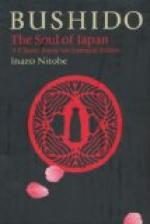Both of these institutions of suicide and redress lost their raison d’etre at the promulgation of the criminal code. No more do we hear of romantic adventures of a fair maiden as she tracks in disguise the murderer of her parent. No more can we witness tragedies of family vendetta enacted. The knight errantry of Miyamoto Musashi is now a tale of the past. The well-ordered police spies out the criminal for the injured party and the law metes out justice. The whole state and society will see that wrong is righted. The sense of justice satisfied, there is no need of kataki-uchi. If this had meant that “hunger of the heart which feeds upon the hope of glutting that hunger with the life-blood of the victim,” as a New England divine has described it, a few paragraphs in the Criminal Code would not so entirely have made an end of it.
As to seppuku, though it too has no existence de jure, we still hear of it from time to time, and shall continue to hear, I am afraid, as long as the past is remembered. Many painless and time-saving methods of self-immolation will come in vogue, as its votaries are increasing with fearful rapidity throughout the world; but Professor Morselli will have to concede to seppuku an aristocratic position among them. He maintains that “when suicide is accomplished by very painful means or at the cost of prolonged agony, in ninety-nine cases out of a hundred, it may be assigned as the act of a mind disordered by fanaticism, by madness, or by morbid excitement."[21] But a normal seppuku does not savor of fanaticism, or madness or excitement, utmost sang froid being necessary to its successful accomplishment. Of the two kinds into which Dr. Strahan[22] divides suicide, the Rational or Quasi, and the Irrational or True, seppuku is the best example of the former type.
[Footnote 21: Morselli, Suicide, p. 314.]
[Footnote 22: Suicide and Insanity.]
From these bloody institutions, as well as from the general tenor of Bushido, it is easy to infer that the sword played an important part in social discipline and life. The saying passed as an axiom which called
THE SWORD THE SOUL OF THE SAMURAI,
and made it the emblem of power and prowess. When Mahomet proclaimed that “The sword is the key of Heaven and of Hell,” he only echoed a Japanese sentiment. Very early the samurai boy learned to wield it. It was a momentous occasion for him when at the age of five he was apparelled in the paraphernalia of samurai costume, placed upon a go-board[23] and initiated into the rights of the military profession by having thrust into his girdle a real sword, instead of the toy dirk with which he had been playing. After this first ceremony of adoptio per arma, he was no more to be seen outside his father’s gates without this badge of his status, even if it was usually substituted for




